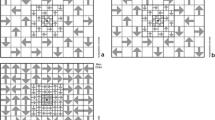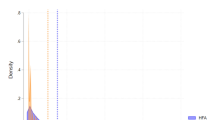Abstract
Purpose
To evaluate the characteristic appearance of induced central visual field defects unrelated to the nerve fiber layer on standard automated perimetry using the Swedish Interactive Threshold Algorithm (SITA), and to compare the findings to the appearance on existing Full Threshold (FT) and FASTPAC (FP) algorithms.
Methods
Thirty right eyes of 30 healthy young participants were examined using four Humphrey 24-2 program algorithms: FT, FP, SITA-Standard (SS), and SITA-Fast (SF). Central visual field defects were induced using a high-density white opacity filter centered on a plano lens. The test duration, fovea threshold, mean sensitivity (MS), mean deviation (MD), pattern standard deviation (PSD), visual field index (VFI), and defect size and depth were compared among all algorithms.
Results
The mean test duration was 21 % to 71 % shorter (p < 0.01), the fovea threshold 0.9 to 2.6 dB higher (p < 0.05), MS 1.1 to 1.7 dB higher (p < 0.05), MD 0.84 to 1.48 dB higher, PSD 0.33 to 0.60 lower, and VFI 2 % higher (p < 0.05) on SS and SF than on FT and FP. The defect size was approximately four points larger and the defect depth 127 to 156 dB shallower on SS and SF than on FT and FP (p < 0.01).
Conclusions
Central visual field defects unrelated to the nerve fiber layer were wider and shallower and global indices were higher on SITA than on conventional FT and FP. These findings indicate that careful attention is required when converting from FT and FP to SITA.






Similar content being viewed by others
References
Gonzalez de la Rosa M, Pareja A (1997) Influence of the “fatigue effect” on the mean deviation measurement in perimetry. Eur J Ophthalmol 7:29–34
Hudson C, Wild JM, O’Neill EC (1994) Fatigue effects during a single session of automated static threshold perimetry. Invest Ophthalmol Vis Sci 35:268–280
Flanagan JG, Moss ID, Wild JM, Hudson C, Prokopich L, Whitaker D, O’Neill EC (1993) Evaluation of FASTPAC: a new strategy for threshold estimation with the Humphrey Field Analyser. Graefes Arch Clin Exp Ophthalmol 231:465–469
O’Donnell NP, Birch MK, Wishart PK (1995) Fastpac error is within the long-term fluctuation of standard Humphrey threshold visual field testing. In: Mills RP, Wall A (eds) Perimetry Update 1994/95. Kugler, Amsterdam, pp 231–237
Schaumberger M, Schafer B, Lachenmayr BJ (1995) Glaucomatous visual fields. FASTPAC versus full threshold strategy of the Humphrey Field Analyzer. Invest Ophthalmol Vis Sci 36:1390–1397
Iwase A, Kitazawa Y, Kato Y (1993) Clinical value of FASTPAC: a comparative study with the standard full threshold method. In: Mills RP (ed) Perimetry Update 1992/93. Kugler, Amsterdam, pp 365–367
Bengtsson B, Heijl A, Olsson J (1997) Evaluation of a new interactive threshold strategy in normal subjects. In: Wall M, Heijl A (eds) Perimetry Update 1996/1997. Kugler, Amsterdam, pp 87–88
Bengtsson B, Olsson J, Heijl A, Rootzen H (1997) A new generation of algorithms for computerized threshold perimetry, SITA. Acta Ophthalmol Scand 75:368–375
Bengtsson B, Heijl A (1998) SITA Fast, a new rapid perimetric threshold test. Description of methods and evaluation in patients with manifest and suspect glaucoma. Acta Ophthalmol Scand 76:431–437
Aoki Y, Takahashi G, Kitahara K (2007) Comparison of Swedish interactive threshold algorithm and full threshold algorithm for glaucomatous visual field loss. Eur J Ophthalmol 17:196–202
Budenz DL, Rhee P, Feuer WJ, McSoley J, Johnson CA, Anderson DR (2002) Comparison of glaucomatous visual field defects using standard full threshold and Swedish interactive threshold algorithms. Arch Ophthalmol 120:1136–1141
Anderson DR, Patella VM (1999) Automated Static Perimetry, 2nd edn. Mosby, St. Louis
Heijl A, Patella VM, Bengtsson B (2012) STATPAC analysis of single perimetry. The field analyzer primer: Effective Perimetry, fourthth edn. Carl Zeiss Meditec, Dublin, pp 45–60
Bengtsson B, Heijl A, Olsson J (1998) Evaluation of a new threshold visual field strategy, SITA, in normal subjects. Acta Ophthalmol Scand 76:165–169
Shirato S, Inoue R, Fukushima K, Suzuki Y (1999) Clinical evaluation of SITA: a new family of perimetric testing strategies. Graefes Arch Clin Exp Ophthalmol 237:29–34
Wild JM, Pacey IE, Hancock SA, Cunliffe IA (1999) Between-algorithm, between-individual differences in normal perimetric sensitivity: full threshold, FASTPAC, and SITA. Swedish Interactive Threshold algorithm. Invest Ophthalmol Vis Sci 40:1152–1161
Roggen X, Herman K, Van Malderen L, Devos M, Spileers W (2001) Different strategies for Humphrey automated perimetry: FASTPAC, SITA standard and SITA fast in normal subjects and glaucoma patients. Bull Soc Belge Ophtalmol 23–33
Schimiti RB, Avelino RR, Kara-Jose N, Costa VP (2002) Full-threshold versus Swedish Interactive Threshold Algorithm (SITA) in normal individuals undergoing automated perimetry for the first time. Ophthalmology 109:2084–2092, discussion 2092
Wild JM, Pacey IE, O’Neill EC, Cunliffe IA (1999) The SITA perimetric threshold algorithms in glaucoma. Invest Ophthalmol Vis Sci 40:1998–2009
Wall M, Punke SG, Stickney TL, Brito CF, Withrow KR, Kardon RH (2001) SITA standard in optic neuropathies and hemianopias: a comparison with full threshold testing. Invest Ophthalmol Vis Sci 42:528–537
Akar Y, Yilmaz A, Yucel I (2008) Assessment of an effective visual field testing strategy for a normal pediatric population. Ophthalmologica 222:329–333. doi:10.1159/000144101
Bengtsson B, Heijl A (1999) Comparing significance and magnitude of glaucomatous visual field defects using the SITA and Full Threshold strategies. Acta Ophthalmol Scand 77:143–146
Budenz DL, Rhee P, Feuer WJ, McSoley J, Johnson CA, Anderson DR (2002) Sensitivity and specificity of the Swedish interactive threshold algorithm for glaucomatous visual field defects. Ophthalmology 109:1052–1058
Heijl A, Bengtsson B, Patella VM (2000) Glaucoma follow-up when converting from long to short perimetric threshold tests. Arch Ophthalmol 118:489–493
Artes PH, Iwase A, Ohno Y, Kitazawa Y, Chauhan BC (2002) Properties of perimetric threshold estimates from Full Threshold, SITA Standard, and SITA Fast strategies. Invest Ophthalmol Vis Sci 43:2654–2659
Bengtsson B, Heijl A (2008) A visual field index for calculation of glaucoma rate of progression. Am J Ophthalmol 145:343–353. doi:10.1016/j.ajo.2007.09.038
Bengtsson B, Patella VM, Heijl A (2009) Prediction of glaucomatous visual field loss by extrapolation of linear trends. Arch Ophthalmol 127:1610–1615. doi:10.1001/archophthalmol.2009.297
Casas-Llera P, Rebolleda G, Munoz-Negrete FJ, Arnalich-Montiel F, Perez-Lopez M, Fernandez-Buenaga R (2009) Visual field index rate and event-based glaucoma progression analysis: comparison in a glaucoma population. Br J Ophthalmol 93:1576–1579. doi:10.1136/bjo.2009.158097
Sharma AK, Goldberg I, Graham SL, Mohsin M (2000) Comparison of the Humphrey Swedish Interactive Thresholding Algorithm (SITA) and full threshold strategies. J Glaucoma 9:20–27
Bengtsson B, Heijl A (1999) Inter-subject variability and normal limits of the SITA Standard, SITA Fast, and the Humphrey Full Threshold computerized perimetry strategies, SITA STATPAC. Acta Ophthalmol Scand 77:125–129
Conflict of interest
All authors certify that they have no affiliations with or involvement in any organization or entity with any financial or non-financial interest in the subject matter or materials discussed in this manuscript.
Author information
Authors and Affiliations
Corresponding author
Rights and permissions
About this article
Cite this article
Hirasawa, K., Shoji, N. Swedish Interactive Threshold Algorithm for central visual field defects unrelated to nerve fiber layer. Graefes Arch Clin Exp Ophthalmol 254, 845–854 (2016). https://doi.org/10.1007/s00417-015-3132-x
Received:
Revised:
Accepted:
Published:
Issue Date:
DOI: https://doi.org/10.1007/s00417-015-3132-x




